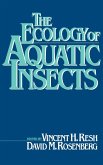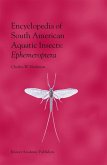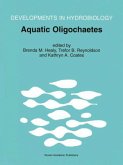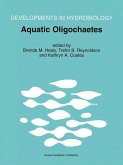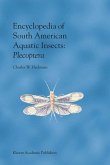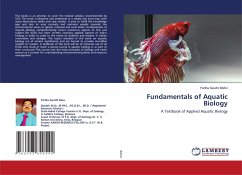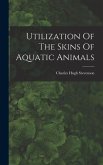Lancaster & Downes
AQUATIC ENTOMOLOGY P
Lancaster & Downes
AQUATIC ENTOMOLOGY P
- Broschiertes Buch
- Merkliste
- Auf die Merkliste
- Bewerten Bewerten
- Teilen
- Produkt teilen
- Produkterinnerung
- Produkterinnerung
A fully up-to-date overview of aquatic insect biology, assuming no detailed knowledge of entomology.
The book is a comprehensive text on all aspects of the biology of aquatic insects around the world. This fauna comprises many thousands of species that previously lacked a dedicated reference text.
Andere Kunden interessierten sich auch für
![The Ecology of Aquatic Insects The Ecology of Aquatic Insects]() Vincent H. ReshThe Ecology of Aquatic Insects83,99 €
Vincent H. ReshThe Ecology of Aquatic Insects83,99 €![Encyclopedia of South American Aquatic Insects: Ephemeroptera Encyclopedia of South American Aquatic Insects: Ephemeroptera]() Charles W. HeckmanEncyclopedia of South American Aquatic Insects: Ephemeroptera163,99 €
Charles W. HeckmanEncyclopedia of South American Aquatic Insects: Ephemeroptera163,99 €![Aquatic Oligochaetes Aquatic Oligochaetes]() HealyAquatic Oligochaetes60,99 €
HealyAquatic Oligochaetes60,99 €![Aquatic Oligochaetes Aquatic Oligochaetes]() Aquatic Oligochaetes38,99 €
Aquatic Oligochaetes38,99 €![Encyclopedia of South American Aquatic Insects: Plecoptera Encyclopedia of South American Aquatic Insects: Plecoptera]() Charles W. HeckmanEncyclopedia of South American Aquatic Insects: Plecoptera154,99 €
Charles W. HeckmanEncyclopedia of South American Aquatic Insects: Plecoptera154,99 €![Fundamentals of Aquatic Biology Fundamentals of Aquatic Biology]() Partha Sarathi BasuFundamentals of Aquatic Biology36,99 €
Partha Sarathi BasuFundamentals of Aquatic Biology36,99 €![Utilization Of The Skins Of Aquatic Animals Utilization Of The Skins Of Aquatic Animals]() Charles Hugh StevensonUtilization Of The Skins Of Aquatic Animals32,99 €
Charles Hugh StevensonUtilization Of The Skins Of Aquatic Animals32,99 €-
-
-
A fully up-to-date overview of aquatic insect biology, assuming no detailed knowledge of entomology.
The book is a comprehensive text on all aspects of the biology of aquatic insects around the world. This fauna comprises many thousands of species that previously lacked a dedicated reference text.
The book is a comprehensive text on all aspects of the biology of aquatic insects around the world. This fauna comprises many thousands of species that previously lacked a dedicated reference text.
Produktdetails
- Produktdetails
- Verlag: OUP UK
- Seitenzahl: 296
- Erscheinungstermin: 20. Juni 2013
- Englisch
- Abmessung: 246mm x 189mm x 17mm
- Gewicht: 577g
- ISBN-13: 9780199573226
- ISBN-10: 0199573220
- Artikelnr.: 37648739
- Herstellerkennzeichnung
- Libri GmbH
- Europaallee 1
- 36244 Bad Hersfeld
- gpsr@libri.de
- Verlag: OUP UK
- Seitenzahl: 296
- Erscheinungstermin: 20. Juni 2013
- Englisch
- Abmessung: 246mm x 189mm x 17mm
- Gewicht: 577g
- ISBN-13: 9780199573226
- ISBN-10: 0199573220
- Artikelnr.: 37648739
- Herstellerkennzeichnung
- Libri GmbH
- Europaallee 1
- 36244 Bad Hersfeld
- gpsr@libri.de
Jill Lancaster is a freshwater ecologist with a long-standing interest in aquatic insects. She received her PhD from the University of London, and held academic positions at the University of Edinburgh and Monash University, until becoming semi-retired and an honorary Principal Research Fellow at the University of Melbourne. In general, Lancaster's research uses freshwater systems and aquatic invertebrates to empirically test ideas in population and community ecology. An over-arching theme lies in understanding how interactions between the physical environment and biological processes influence ecological systems. She has published many peer-reviewed papers in international journals and held editorial positions for several journals. Barbara Downes is an aquatic ecologist who has worked in a wide range of different ecosystems including lowland rivers, upland streams, wetlands, and intertidal and subtidal rocky reefs. She received her PhD from Florida State University in 1988 and, after several postdoctoral fellowships, joined the University of Melbourne in 1995, where she has remained ever since. Her research seeks to understand factors that limit population numbers and that maintain species diversity in freshwater systems. Her interest in insects springs from a fascination with species having complex life cycles that span both freshwater and terrestrial environments. She has published numerous peer-reviewed papers and two books and has served as an editor for several international journals.
Part 1 - Introduction to Aquatic Insects
1: Insect body structure and the aquatic insect orders
2: Evolution, biogeography, and aquatic insect distributions
Part 2 - Environmental constraints on distribution
3: Gas exchange
4: Physico-chemical gradients and extremes
5: The biomechanics of living in and on water
Part 3 - Sensory systems, movement, and dispersal
6: Sensory systems - photoreception
7: Sensory systems - mechano- and chemoreception
8: Locomotion in and on water
9: Dispersal in the terrestrial environment
Part 4 - Population dynamics and population persistence
10: Reproduction and mating behaviour
11: Oviposition and eggs
12: Development
Part 5 - Trophic relationships
13: Feeding devices and foraging strategies
14: Diet, digestion, and defecation
References
1: Insect body structure and the aquatic insect orders
2: Evolution, biogeography, and aquatic insect distributions
Part 2 - Environmental constraints on distribution
3: Gas exchange
4: Physico-chemical gradients and extremes
5: The biomechanics of living in and on water
Part 3 - Sensory systems, movement, and dispersal
6: Sensory systems - photoreception
7: Sensory systems - mechano- and chemoreception
8: Locomotion in and on water
9: Dispersal in the terrestrial environment
Part 4 - Population dynamics and population persistence
10: Reproduction and mating behaviour
11: Oviposition and eggs
12: Development
Part 5 - Trophic relationships
13: Feeding devices and foraging strategies
14: Diet, digestion, and defecation
References
Part 1 - Introduction to Aquatic Insects
1: Insect body structure and the aquatic insect orders
2: Evolution, biogeography, and aquatic insect distributions
Part 2 - Environmental constraints on distribution
3: Gas exchange
4: Physico-chemical gradients and extremes
5: The biomechanics of living in and on water
Part 3 - Sensory systems, movement, and dispersal
6: Sensory systems - photoreception
7: Sensory systems - mechano- and chemoreception
8: Locomotion in and on water
9: Dispersal in the terrestrial environment
Part 4 - Population dynamics and population persistence
10: Reproduction and mating behaviour
11: Oviposition and eggs
12: Development
Part 5 - Trophic relationships
13: Feeding devices and foraging strategies
14: Diet, digestion, and defecation
References
1: Insect body structure and the aquatic insect orders
2: Evolution, biogeography, and aquatic insect distributions
Part 2 - Environmental constraints on distribution
3: Gas exchange
4: Physico-chemical gradients and extremes
5: The biomechanics of living in and on water
Part 3 - Sensory systems, movement, and dispersal
6: Sensory systems - photoreception
7: Sensory systems - mechano- and chemoreception
8: Locomotion in and on water
9: Dispersal in the terrestrial environment
Part 4 - Population dynamics and population persistence
10: Reproduction and mating behaviour
11: Oviposition and eggs
12: Development
Part 5 - Trophic relationships
13: Feeding devices and foraging strategies
14: Diet, digestion, and defecation
References


